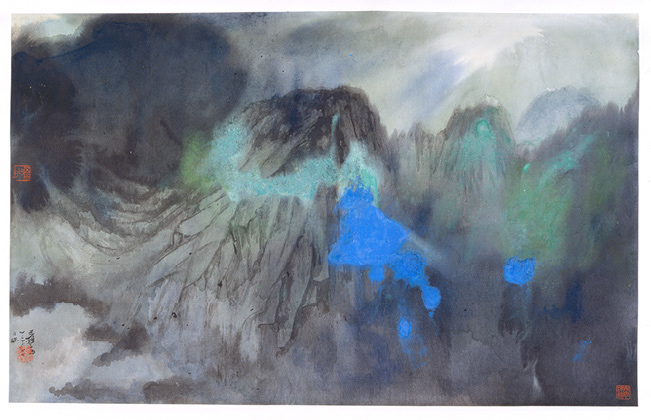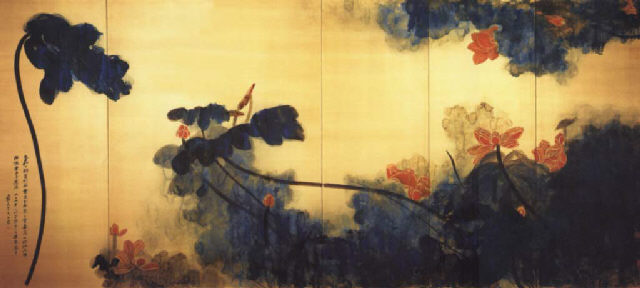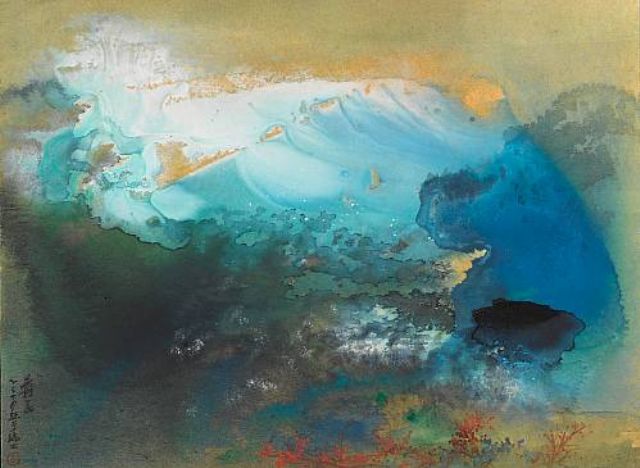Zhang Daqian
Chinese Painter, 1899-1983
178 Zhang Daqian
Peach Blossom Spring
1983
hanging scroll, ink and color on paper
209.1 x 92.4 cm
Cemac Ltd.
Published in:
Julia F Andrews and Kuiyi Shen, A Century in Crisis:
Modernity and Tradition in the Art of Twentieth-Century China
(New York: Guggenheim Museum, 1998), Pl. 178.
Chang Dai-chien continued to develop his remarkable range of techniques
after he left China in 1949.
One particularly important breakthrough was his development, in the 1960s,
of a bold technique of splashing ink and color on his paper.
Although the results might seem to resemble action painting,
Chang maintained throughout his life that his technique was Chinese,
having been described in Tang dynasty texts on painting.
He did not, thus, use the splashed ink technique in a purely abstract manner,
but only to suggest real or imaginary landscapes.
In this superb painting of his final years,
his blue-and-green pigment is used to suggest a mythical paradise,
the Peach Blossom Spring, where human discord was unknown.
Although he never returned to mainland China,
his work was admired and emulated
by younger artists who came to know it after the Cultural Revolution.
Splashed-color Landscape, dated 1965
Zhang Daqian (Chinese, 1899–1983)
Hanging scroll; ink and color on paper; 23 3/4 x 37 3/4 in. (60.3 x 95.9 cm)
Inscribed by the artist
Gift of Robert Hatfield Ellsworth,
in memory of La Ferne Hatfield Ellsworth, 1986 (1986.267.361)
After 1949, Zhang lived for a time in Hong Kong and India
before building residences in São Paolo, Carmel (in California), and Taiwan.
His long residency outside China inevitably brought him into contact with currents of modern Western art,
including Abstract expressionism.
This work, painted with intense mineral colors and broad washes of layered ink,
may represent Zhang's response to such influences.
Zhang maintained that such works, which first appeared in 1956, when he was in Europe,
derived from the "broken-ink" techniques of random splashing and soaking used by Tang dynasty (618–907) artists,
but it seems more likely that his encounter with Western abstract art
encouraged him to carry further the Japanese technique of splashed colors that he had used in earlier works.
Clearly he welcomed the liberating effect of this painting mode on his creativity,
which gave a spontaneity to his compositions.
In spite of their abstract qualities, however, these paintings remained resolutely descriptive of the natural world.
Here, Zhang first applied ink and color in a seemingly random manner,
then added contour lines and other pictorial details
in order to transform his composition into a highly suggestive vision of storm-engulfed mountains
suddenly illuminated by a burst of sunlight that has turned the somber clouds iridescent.
Zhang Daqian
Abstract blue and green landscape
ink and color
33.5 x 120.5 in. / 85 x 306 cm.
Signed, Inscribed, Stamped
Zhang Daqian
Crimson lotuses on gold screen (6 panel screen)
Ink with Color on Silk
66.1 x 145.3 in. / 168 x 369 cm.
1975
Signed, Inscribed, Stamped
Zhang Daqian
Early snow
ink and color on gold paper board
17.7 x 23.6 in. / 45 x 60 cm.
1965 -
Signed, Inscribed, Stamped
Lotus
Ink Painting
Chang Dai-chien [Zhang Daqian] (1899-1983) was a native of Nei-chiang, Szechwan. His original given name Chuan was later changed to Yuan, while his childhood name Chi was later incorporated into his studio name Chi-yuan. He took the religious name Dai-chien upon becoming a Buddhist monk, and after returning to the laity he called himself Dai-chien chu-shih or "Lay believer Dai-chien."
At the age of 21 he studied under Tseng Hsi and Li Jui-ching. Taking Shih Tao and Pa-ta Shan-jen ![]() as his starting point, he sought out as many paintings by famous artists of past centuries as he could to copy. Beginning with an impressionistic style and progressing to meticulous brushwork, he developed the ability to move between these techniques with complete master. In 1941 he traveled to DunHuang where he spent two years and seven months copying wall paintings. Here he studied traditional coloration and line drawing methods, being particularly moved by the grand scale and complex layout of the high Tang style. The sumptuous splendor of high Tang art inspired him with the desire to create great art.
as his starting point, he sought out as many paintings by famous artists of past centuries as he could to copy. Beginning with an impressionistic style and progressing to meticulous brushwork, he developed the ability to move between these techniques with complete master. In 1941 he traveled to DunHuang where he spent two years and seven months copying wall paintings. Here he studied traditional coloration and line drawing methods, being particularly moved by the grand scale and complex layout of the high Tang style. The sumptuous splendor of high Tang art inspired him with the desire to create great art.
Besides copying from old masters Chang Dai-chien was also expert at painting from life.
Chang Dai-chien traveled widely in Europe and America, where he came into contact with the contemporary art movement in the West. This spurred a sea change in his methods of painting, and he created unique splashed-ink and splashed-color styles, expanding the potential of plane surfaces and coloration. In his later years, he combined splashed ink and splashed color with the masterly texture strokes and liberation of his early years to form a new synthesis. Hovering between concrete and abstract, reveling in freedom and unpredictability, Chang Dai-chien's work created a whole new style of modern Chinese painting.
-- By Chen Kang-Shun
Encyclopædia Britannica Article
born May 10, 1899, Neijiang, Sichuan province, China
died April 2, 1983, Taipei, Taiwan
Wade-Giles romanization Chang Ta-ch'ien painter and collector who was one of the most internationally renowned Chinese artists of the 20th century.
As a child, Zhang was encouraged by his family to pursue painting. In 1917 his elder brother, Zhang Shanzi (an artist famous for his tiger paintings), accompanied him to Kyoto, Japan, to study textile dyeing. Two years later, Zhang Daqian went to Shanghai to receive traditional painting instruction from two famous calligraphers and painters of the time, Zeng Xi and Li Ruiqing. Through his association with these teachers, Zhang had the opportunity to study some works by ancient masters in detail. His early style attempted to emulate the Ming-Qing Individualists, including Tang Yin, Chen Hongshou, and Shitao. He meticulously studied and copied their works and began to make forgeries; he gained notoriety when one of his forged Shitaos successfully deceived the connoisseurs.
After his early success in Shanghai, Zhang extended his career to the north in the late 1920s, when he became active in the cultural circles of Beijing. He began to collaborate with the well-known Beijing painter Pu Xinyu, and together they became known as the “South Zhang and North Pu,” an epithet that is still used to refer to their collaborative works of the 1930s.
In 1940 Zhang led a group of artists to the caves of Mogao and Yulin for the purpose of copying their Buddhist wall paintings. The group completed over 200 paintings, and the experience left Zhang with a repository of religious imagery. During the Sino-Japanese War, the artist zealously studied traditional Tang-Song figure painting and ancient monumental landscape painting. He would use elements of these in his own work, becoming particularly known for his lotus paintings, inspired by ancient works. His love of tradition was also reflected in his personal collection of ancient Chinese paintings, which he began early in his career. At its peak, his collection contained several hundred works from the Tang to Qing dynasties.
In reaction to the political climate in 1949, Zhang left China in the early 1950s. He resided in various places, including Mendoza, Argentina; São Paulo, Brazil; and Carmel, California. His meeting with Pablo Picasso in 1956 in Nice, France, was publicized as an artistic meeting between East and West.
Zhang developed eye problems in the late 1950s. As his eyesight deteriorated, he developed his mature splashed colour (pocai) style. Although he attributed this style in part to the splashed-ink technique of the ancient painter Wang Mo, many believe it to be related to that of the Abstract expressionist movement then popular in the United States and a departure from that of his traditional paintings. Zhang's splashed-colour paintings fetched the highest market prices for contemporary Chinese paintings at international auctions of the time.
In 1978 the artist settled in Taipei, Taiwan. His residence, Moye-jingshe, next to the National Palace Museum, is now the Memorial Museum of Zhang Daqian.
http://kaladarshan.arts.ohio-state.edu/exhib/gug/indxs/tran/tranchinptg.html
http://www.metmuseum.org/toah/ho/11/eac/ho_1986.267.361.htm
http://www.britannica.com/eb/article-9022428/Zhang-Daqian
http://www.artcyclopedia.com/artists/zhang_daqian.html
http://www.artnet.com/artist/598824/zhang-daqian.html
http://www.chinapage.com/biography/changda1.html
http://www.chinapage.com/painting/zhangdaqian/zhangdaqian.html
http://www.denverartmuseum.org/explore_art/collections/objectDetails/objectId--104886
http://www.icm.gov.mo/exhibition/daqian/BiographyE.asp
http://www.mfa.org/exhibitions/sub.asp?key=15&subkey=5340
http://english.peopledaily.com.cn/200403/18/eng20040318_137829.shtml
http://wwar.com/masters/z/zhang_daqian.html
'Blue > e—art—museum' 카테고리의 다른 글
| Nothing can restrict Fine Art no rules painting (0) | 2008.08.06 |
|---|---|
| Attraction of Man with Art (0) | 2008.08.02 |
| Legend of Lady Godiva (0) | 2006.07.14 |
| 한국미술 100 년 2부 (0) | 2006.06.11 |
| [스크랩] The Worlds of Nam June Paik (0) | 2006.02.04 |









